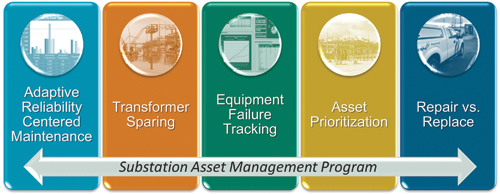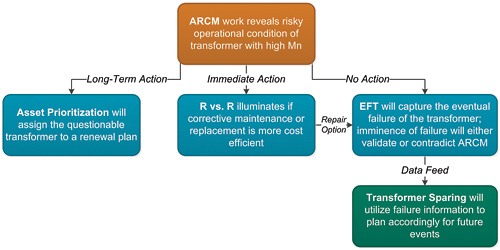Introduction
On August 21, 2000, Northern States Power Co. (NSP) and New Century Energies (NCE) merged to form Xcel Energy. After the merger was complete, Xcel Energy became the fourth largest combination utility in the country. Due to the increased scale of the company’s asset base, new interest arose in formulating a unified methodology for management of the essential substation grid components.
Xcel Energy’s comprehensive approach to substation asset management can be thought of in terms of the individual programs that make up the bigger picture. Through the application of targeted plans, the company has been able to mitigate both immediate and long-term risk to the systems, as well as uphold efficient decision-making criteria in the event of a failure.
The newly systematized philosophy allowed all business processes and programs to meet the following criteria: transparency, repeatability, objectivity, and data-centrality. With those factors, the goal was to develop, implement, and execute programs that would focus resources on the right asset at the right time. Unknowingly, this endeavor prompted interconnections among the various programs, which ultimately formed the components to the overall Substation Asset Management system. These components include: Adaptive Reliability Centered Maintenance, Transformer Sparing Strategy, Equipment Failure Tracking, Asset Prioritization, and Repair versus Replace (see Figure 1).

Figure 1: Programs in Xcel Energy’s Substation Asset Management Platform
Programs
- Adaptive Reliability Centered Maintenance (ARCM)
The primary mechanism of the ARCM program is the assignment of a Maintenance Number (Mn) to each individual asset of the substation asset base through a complex algorithm. This algorithm accounts for both static and operational data related to an individual asset. Some examples of input data and parameters into the Maintenance Number algorithm include:- Equipment type
- Age
- Condition
- Time since last maintenance activity
- Asset criticality
- Fault and routine operations
Once a Mn has been calculated for each of the individual assets, program managers will be able to identify the assets most in need of maintenance, or those with the highest Mn. These identified high-risk assets will be annually assigned to the ARCM work portfolio, which also indicates the type of preventative maintenance work to be performed on the portfolio assets.
- Transformer Sparing Strategy
Due to the heightened criticality and system resiliency associated with power transformers, sparing has been a long-held practice for this equipment type at Xcel Energy. A major component of Xcel Energy’s strategy to transformer sparing relies on forecasting failure patterns to effectively minimize risk.
One way to analyze potential failures in the transformer asset base is by filtering failure rates based on voltage classification. Once a rate has been determined for each voltage class, a spare recommendation can be generated to ensure coverage of one, two, or three standard deviations above the expected failure count. Since any given spare will only apply to certain voltage levels, this method is useful for calculating the actual needs of the system. The selection of the amount of failure coverage depends on the perceived level of acceptable risk.
- Equipment Failure Tracking (EFT)
The Equipment Failure Tracking (EFT) program encompasses the capture and analysis of failure data related to distribution and transmission substation assets, including power transformers and circuit breakers. This process provides a twofold advantage of pinpointing common failure types for deeper analysis and identifying emerging trends in failure rates.
The collected failure data is also used to feed into the Industry-wide Database (IDB), assembled by the Electric Power Research Institute (EPRI). With Xcel Energy’s participation, the company will be able to better benchmark performance against other utilities and will also benefit from the failure analytics made possible by the larger pool of data.
- Asset Prioritization
The Asset Prioritization program is a proactive measure for identifying and ranking top equipment replacement candidates. This decision making process feeds directly into the long term capital renewal program, in which the recommendations of the asset prioritization algorithm are actualized into strategic upgrades in the system.
There are two main inputs to the asset prioritization rank: 1) the criticality of the asset, and 2) the overall health and condition of the asset. Individual asset criticality is determined through existing information on the related system impacts, financial impacts, and black start path reliance. System impacts can be thought of as the implications to system restructuring and restrictions if the evaluated asset were removed, while financial impacts concern the monetary expense associated with asset removal. Black start path reliance simply refers to the importance of the analyzed asset in the event of grid re-energization.
- Repair versus Replace (R vs. R)
The Repair versus Replace (R vs. R) program offers a standardized procedure for the evaluation of options following the signal or occurrence of a failure. As indicated by the program title, the binomial output of the program’s algorithm can recommend either a repair or replacement of the failed equipment.
The R vs. R process is prompted after either a sudden failure has occurred or an alarm has been activated to indicate the suspect equipment must be repaired or replaced to maintain system reliability. If a preliminary determination is made that both the repair and replace options are viable, the algorithm will be run to return a recommended course of action. This mechanism offers a valuable tool when a failure occurs that does not command a clear course of action. The algorithm provides objective, transparent and repeatable results for instances in which human subjectivity or engineering judgment alone is insufficient to make the final decision.
Program Interconnections
- R vs. R and ARCM
For most assets in the annual ARCM portfolios, the preventive maintenance is carried out as expected and no further actions are taken other than potential corrections to the asset database. However, significant operational issues can sometimes be revealed during the standard ARCM procedures. For these cases, there is an option to either perform corrective maintenance on the asset or perform a replacement; thus, the R vs. R program comes into play by quickly suggesting an answer to these ambiguous situations. The R vs. R program is an important support to the ARCM program in such instances to ensure final decisions are made true to the consistent, repeatable, and transparent criterions.
- EFT Validation of ARCM and R vs. R
Since both ARCM and R vs. R are relatively new programs, validation of the results and continual refinements have been implemented to provide usefulness and enhance credibility of the programs. To assess their validity, Xcel Energy surveys failure data captured by the EFT program. For example, if the ARCM program indicated maintenance was due for a failed asset, there would be positive confirmation of Maintenance Number algorithm. For the R vs. R program, the EFT program analyzes the validity of the repair decision. If an asset fails shortly after major repairs have been completed, scrutiny would be given to the R vs. R’s decision to have had a repair completed. Another aspect of the two programs’ interdependency concerns R vs. R’s utilization of EFT failure tracking rates, which are used in determining the cost effectiveness of each possible decision. Finally, the information stored within the EFT program informs the asset manager of poor performing assets and helps avoid directing financial resources toward repairing these assets.
- Transformer Sparing Analysis with EFT and ARCM
Informed transformer sparing requires sufficient amounts of reputable data. Two important sources of data stem from the EFT and ARCM programs. The EFT records the age of assets at their time of failure, which is then used to generate age-based failure probabilities. Likewise, the individual Maintenance numbers of the ARCM program can be used to form an overall picture of system risk. In response, sparing can be adjusted accordingly to cover the perceived level of operational risk. The accuracy of the collected failure rates will determine the quality of the transformer sparing analysis results. As such, the data quality improvement of EFT will go hand-in-hand with the analytical results of the transformer sparing studies.
- ARCM Portfolio and Asset Prioritization
The R vs. R program is applied following the discovery of an immediate or impending equipment failure. However, assets do not necessarily require removal or pose any immediate risk to system performance for long-term capital renewal scenarios. In this case, the Asset Prioritization program is used with the ARCM program, which assists in determining the right assets to be included into the long-term capital renewal portfolio. Depending on the capital resources available, the asset manager can select the appropriate number of prioritized assets to be placed in a renewal portfolio for a specific cycle or period. This portfolio is then delivered to the ARCM program managers to prevent use of O&M funds on assets that are already elected for replacement in the upcoming term. The combined information of the Asset Prioritization program and the ARCM program helps the asset manager obtain a clear view of how resources should be dedicated and removes accidental overlap of resource allocations.

Figure 2: Example of Program Interconnections for Identified High-Risk Transformer
Conclusion
Xcel Energy continues to modernize and improve its internal asset management business processes. Through the development, implementation, and evolution of each program, the organization has benefited from increased knowledge and understanding of effective and efficient substation asset management techniques from both an operational and strategic perspective.
As strengthened visibility of system risk across the substation asset fleet has become available, the organization’s ability to make short and long term decisions throughout asset life cycles has improved. Although a greater focus has been given to the uniformity, transparency, and outcome repeatability of business processes and metrics, the fundamentals of equipment operation and maintenance have remained consistent through the years. To account for future changes, Xcel Energy has designed its substation asset management program to accommodate continuous improvement as technical insight and technology progresses.
About the Authors
 Ming-Wa Hui is a substation system performance manager at Xcel Energy. He has more than 18 years’ experience in the Power Engineering field. His focus primarily centers on transmission and distribution substation operations and maintenance. Most recently, his work has been dedicated to the development of substation asset management programs, with emphasis on long term capital finance strategies, asset life cycle decision-making, and asset prioritization analytics. He has a B.S in electrical engineering, Master of Engineering, and Master of Business Administration. Hui is a U.S. Army veteran who served with the 19th SFG(A)
Ming-Wa Hui is a substation system performance manager at Xcel Energy. He has more than 18 years’ experience in the Power Engineering field. His focus primarily centers on transmission and distribution substation operations and maintenance. Most recently, his work has been dedicated to the development of substation asset management programs, with emphasis on long term capital finance strategies, asset life cycle decision-making, and asset prioritization analytics. He has a B.S in electrical engineering, Master of Engineering, and Master of Business Administration. Hui is a U.S. Army veteran who served with the 19th SFG(A)
 Katherine T Decker works as an engineering intern with the Substation System Performance team at Xcel Energy. She started with the company in May 2015 and has aided in the creation of transparent analytical and communication tools related to Xcel Energy’s asset management system. Decker received B.S. degrees in chemical engineering and biochemical engineering from Colorado School of Mines.
Katherine T Decker works as an engineering intern with the Substation System Performance team at Xcel Energy. She started with the company in May 2015 and has aided in the creation of transparent analytical and communication tools related to Xcel Energy’s asset management system. Decker received B.S. degrees in chemical engineering and biochemical engineering from Colorado School of Mines.






